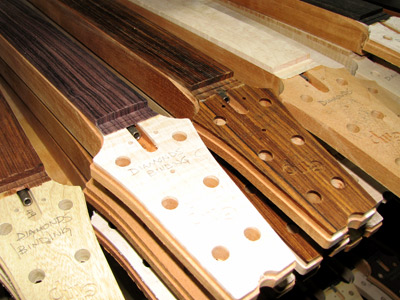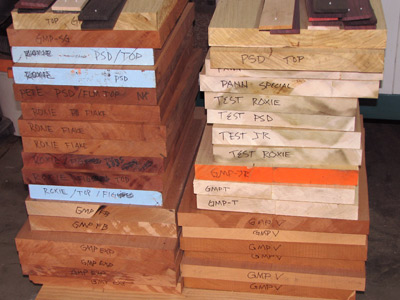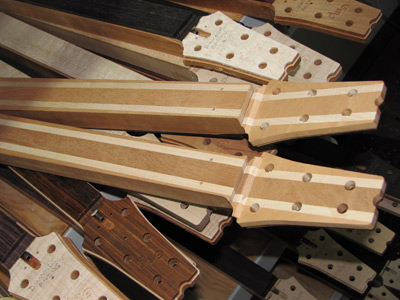|
"Tone for Days"
Since wood is a natural product each piece is unique
and has its own markings, tone and characteristics. Some woods are rare
and hard to come by and can vary in price and availability, and quite frankly
can be very difficult to obtain at times. Please inquire should you
have specific needs or questions.
Some woods have a more harmonic relationship
when put together than others.
If you are unfamiliar or unsure with the different tones and/or woods, please inquire directly
with our master
builders during our regularly scheduled business hours at 909.592.5144 or
contact us via
e-mail
TONE WOODS
Alder
carries a full and rich tone along with fat low-end, nice mids, and good overall range. Alder is considered to be one of the
favorites throughout the guitar industry. Medium in weight with good balance.
Ash
has a bright edge and a
"snappier" tone. Extends with a warm bass and long sustain. Used for many years in the traditional guitar market and is considered the popular body wood.
It has beautiful grain patterns and can be heavy or light depending on its
origin. It is also known as Swamp Ash.
Ebony is the
fingerboard wood of choice within the guitar industry. It is very dense
and stable which will create a bold sound with incredible sustain. It has a
smooth finish and comes in different grain colors from black to chocolate striping.
Koa is highly
figured and is considered a prized wood for both its beauty and influence on
sound. Koa produces a warm rich sound with a more midrange tone. Koa is
becoming more difficult and expensive to obtain. This wood is likely
to see a dramatic rise in price over the next several years. Koa is native to Hawaii.
Korina is also known as
White Limba. This wood is lighter in color, but has much of the same tonal
characteristics as some Mahogany species. This wood was popular and widely
used in the guitar industry starting in the late 50's to date.
Mahogany gives you the
deep warm mids with good sustain on the bottom end and
a nice "bite" to go along. Sometimes
can be on the heavy side.
Maple
tends to be punchy, bright, and gives a
nice clean bite on the high end. Often used only as a laminated top instead of an entire body. Maples tend to be
heavy but not always. Figured tops used would be Quilted, Flamed and sometimes Birdseye.
Poplar this is
one of the softer hardwoods that carries a nice resonance with a meaty tone.
Many guitar manufacturers use it as a substitute for Alder. The tone is very
similar to Alder. Medium in weight.
Rosewood
is another popular fingerboard material used
within the guitar industry. It is dense and stable but not to the extent
of Ebony. Rosewood will add to a slightly warmer tone and adds a
different feel to the touch.
Walnut
is an excellent tonewood falling between the
warm sounds of East Indian Rosewood and the bright bell-like ring of Maple.
Sometimes with figuring and others with straight grain, colors vary from chocolate browns, black and
beiges.
"Some woods are made to be seen and heard"



You may have noticed that we do not have Brazilian Rosewood listed as one of our
tonewood options. GMP®
does not offer Brazilian Rosewood as this species is endangered and listed on
the CITES treaty. We believe the expense related to Brazilian Rosewood
does not enhance the sound or value of the instrument in a justifiable way.
We firmly believe that a well-built high quality Indian Rosewood instrument
produces the same warm, rich, responsive tone as its much-coveted Brazilian
cousin.
|
